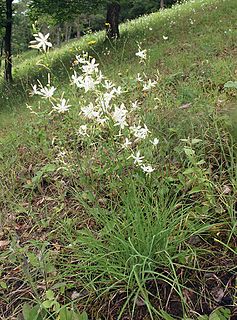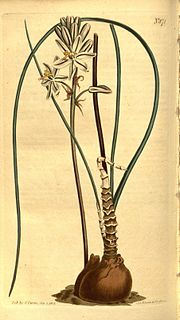
Scilloideae is a subfamily of bulbous plants within the family Asparagaceae. Scilloideae is sometimes treated as a separate family Hyacinthaceae, named after the genus Hyacinthus. Scilloideae or Hyacinthaceae include many familiar garden plants such as Hyacinthus (hyacinths), Hyacinthoides (bluebells), Muscari and Scilla and Puschkinia. Some are important as cut flowers.

Anthericum is a genus of about 65 species, rhizomatous perennial plants in the family Asparagaceae, subfamily Agavoideae. It was formerly placed in its own family, Anthericeae. The species have rhizomatous or tuberous roots, long narrow leaves and branched stems carrying starry white flowers. The members of this genus occur mainly in the tropics and southern Africa and Madagascar, but are also represented in Europe.

Drimia maritima is a species of flowering plant in the family Asparagaceae, subfamily Scilloideae. This species is known by several common names, including squill, sea squill, sea onion, and maritime squill. It may also be called red squill, particularly a form which produces red-tinged flowers instead of white. It is native to southern Europe, western Asia, and northern Africa.
The Namib long-eared bat is a species of vesper bat in the family Vespertilionidae found in Namibia. It is found in these habitats: dry savanna and temperate desert.

Aloe namibensis is a species of plant in the genus Aloe. It is endemic to Namibia. Its natural habitat is rocky areas. It is threatened by habitat loss.
Brownanthus namibensis is a species of plant in the family Aizoaceae. It is endemic to Namibia. Its natural habitat is rocky areas. It is threatened by habitat loss.

Brownanthus is a genus of plant in family Aizoaceae.
Euphorbia namibensis is a species of plant in the family Euphorbiaceae. It is endemic to Namibia. Its natural habitat is cold desert.

Helicia is a genus of 110 species of trees and shrubs, constituting part of the plant family Proteaceae. They grow naturally in rainforests throughout tropical South and Southeast Asia, including India, Sri Lanka, Indochina, Peninsular Malaysia to New Guinea and as far south as New South Wales.
Drimia secunda is a species of plant that is endemic to Namibia. Its natural habitats are rocky areas and cold desert.
Rhadamanthus was a just ruler in Greek mythology, son of Zeus and Europa.
Duthiea is a genus of Asian plants in the grass family.

Drimia is a genus of flowering plants. In the APG IV classification system, it is placed in the family Asparagaceae, subfamily Scilloideae. When broadly circumscribed, the genus includes a number of other genera previously treated separately, including Litanthus, Rhodocodon, Schizobasis and Urginea.
Drimia indica is a species of flowering plant found from South Asia to South Africa.

Fusifilum is a genus of bulbous flowering plants in the family Asparagaceae, subfamily Scilloideae. It is distributed in southern Africa. Some sources consider that all the species should be placed in the genus Drimia.
Drimia nagarjunae is a species of flowering plant in the family Asparagaceae, subfamily Scilloideae. It was included in Drimia indica, but is accepted as a separate species. It is distributed in south India.

Chondrodactylus angulifer, also known as the common giant ground gecko, the South African ground gecko, or the Namib sand gecko, is a species of gecko, a lizard in the family Gekkonidae. The species is endemic to southern Africa.

Drimia exuviata ("Gifbol") is a species of flowering plant in the family Asparagaceae, subfamily Scilloideae, indigenous to the south-western parts of South Africa.
Drimia capensis ("Maerman") is a species of geophytic flowering plant in the family Asparagaceae, subfamily Scilloideae, indigenous to the south-western parts of South Africa.










